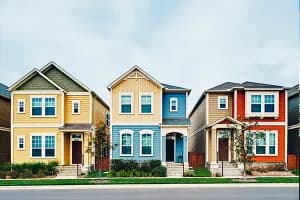As the holidays approach, there’s plenty to appreciate in the way homes are evolving. Forget cookie-cutter designs—today’s trends are all about warmth, individuality and functionality. Here are a few standout home trends worth giving thanks for:
1. More personality, less cookie-cutter
The all-white kitchen and all-gray interior had their moment, but homeowners are craving color and character. Think tuxedo kitchens—contrasting upper and lower cabinets—bold backsplashes, and interiors that feel one-of-a-kind. Spaces are getting a personal stamp with a custom, memorable look.

2. Natural touches
Biophilic design—bringing nature indoors—continues to rise in popularity. From natural stone and wood finishes to greenery that softens a room, homeowners are looking for calm, grounded interiors that feel connected to the outdoors.

3. Texture, texture, texture
It’s no longer just about how a space looks, but also how it feels. Textured elements—like boucle fabrics, grasscloth, fluted wood and handcrafted details—are adding dimension and depth. These tactile surfaces bring warmth and encourage people to literally reach out and touch.

4. The dirty kitchen
Open floor plans may be beautiful, but they don’t leave much room to hide the mess. Enter the “dirty kitchen” or “back kitchen”—a hidden prep space or pantry often equipped with appliances and cooking surfaces. It’s the perfect sanity-saver, allowing everyday chaos to stay out of sight while the main kitchen remains a spotless, sleek showpiece for the home.

5. Accessibility with style
Designing for longevity is top of mind. Homeowners are embracing spaces that work for them now and later, blending function and style seamlessly. According to Houzz’s 2025 Bathroom Trends Study, one in six renovated bathrooms now features a wet room—an open-concept design where the shower or tub flows into the rest of the room without bulky enclosures. These layouts not only maximize space and look modern, but they also make bathrooms more accessible for all ages and mobility levels.
The report also shows more remodeling homeowners are increasingly prioritizing nonslip flooring, grab floors, built-in seating and adopting more low-fuss maintenance design elements, like large-format tiles.










